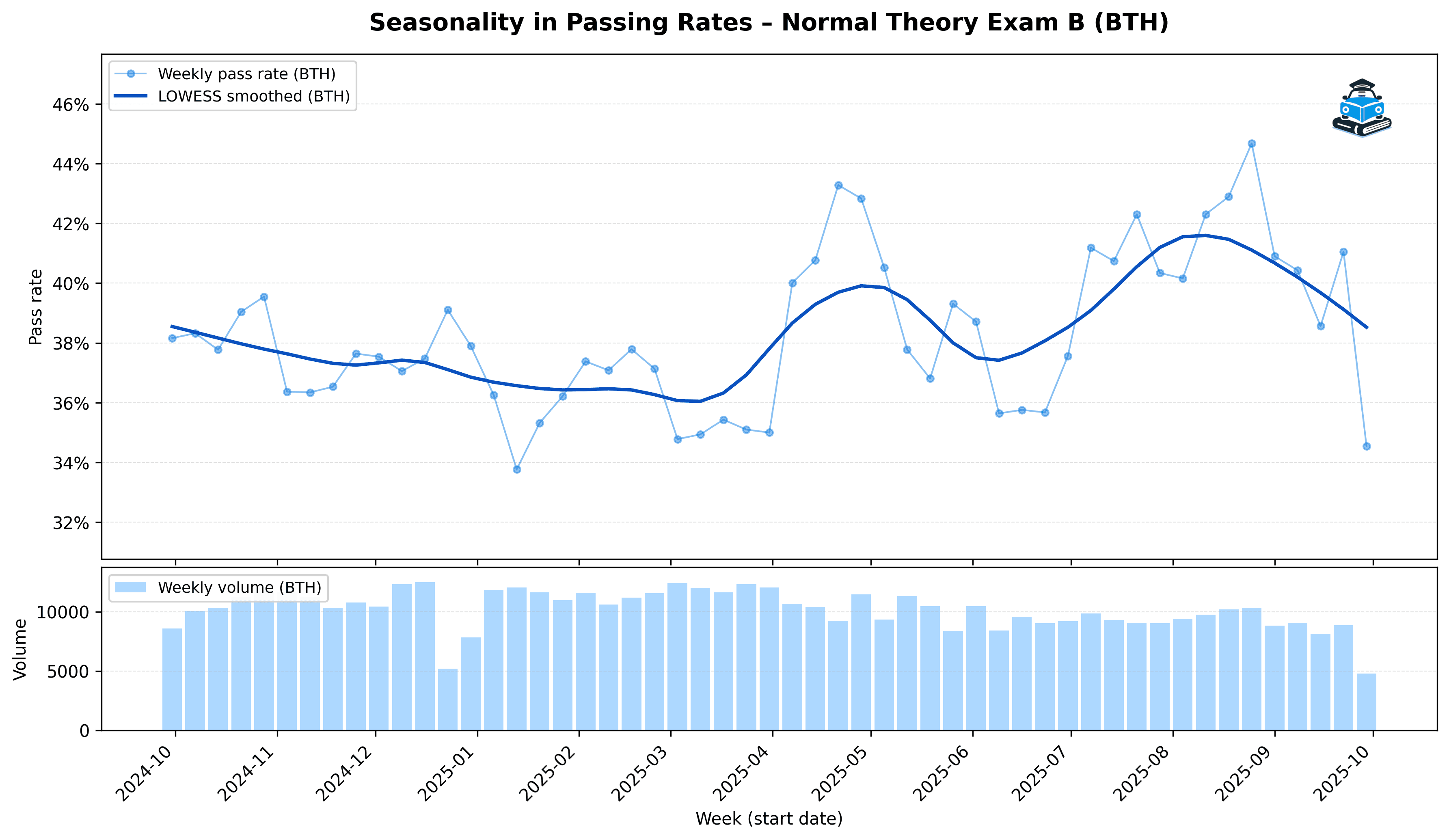License Pass Report · Category BTH
Seasonality in Theory Exam Pass Rates – License B (BTH)
Time horizon: 2024–2025
Published: November 15, 2025

Average pass rate
38.3%
Analyst note
Weekly BTH theory pass rates are low on average (around 38%), but show clear seasonal waves: weaker outcomes in winter, a mid-spring bump, and another improvement in late summer before dropping again at the end of the period.
How stable are B-theory results over the year?
This figure shows weekly pass rates for the normal B theory exam (BTH) between October 2024 and September 2025, together with a smoothed LOWESS trend line and the weekly number of exams.
The raw weekly percentages jump around from week to week, but the LOWESS curve makes the overall pattern easier to see: the BTH pass rate is structurally low, and seasonality plays a visible role.
1. Overall performance level
Across the 53 weeks:
- Average pass rate: 38.30%
- Typical range: roughly 34%–45%
- Half of all weeks fall between 36.3% and 40.3%.
- Total exams: 540,909 normal B theory tests
- Average volume per week: about 10,200 exams, with a peak of 12,504 in week 2024/51 and a low of 4,782 in week 2025/40.
So, fewer than 4 in 10 candidates pass the B theory exam on a given attempt. That makes preparation and mock exams crucial.
2. Seasonal pattern in pass rates
The smoothed curve reveals three main phases:
-
Autumn–winter dip
From October into early spring, pass rates gradually slide down from around 38–39% towards the mid-30s. This is the weakest period in the year, even though volumes stay high. -
Spring improvement
From around March–May, pass rates climb back towards 39–40%, forming a visible “hump” in the curve. This suggests that candidates in late spring perform somewhat better on average. -
Late-summer lift, followed by an autumn drop
In late summer, pass rates again move into the 40–42% band before dropping sharply towards the end of the period, where a very weak week (around 34%) pulls the curve down.
Importantly, exam volume remains high and relatively stable throughout most of the year, so these patterns are not simply artifacts of a few small weeks. Instead, they likely reflect changes in candidate mix, study habits (holidays, school terms), and possibly the impact of resits coming through.
3. Practical takeaways
- Expect a tough exam: with an average pass rate under 40%, the BTH theory test is demanding. Most candidates will not pass on the first try.
- Timing can help at the margin: the data hints that spring and late summer are slightly more favourable periods, while deep winter and late autumn appear weaker. This should not replace good preparation, but it is useful context when planning.
- Volume is huge: over half a million theory tests in a year means the results are based on a very large sample. The low pass rate is therefore a structural feature, not a fluke.
For students and driving schools, the message is clear: invest time in theory preparation, use practice exams, and avoid assuming that simply “waiting for a quiet week” will change the odds. The seasonal pattern matters, but solid study habits matter even more.
Source: https://www.cbr.nl/nl/service/nl/artikel/1-oktober-2024-tm-30-september-2025